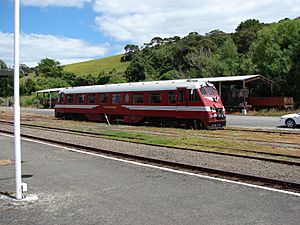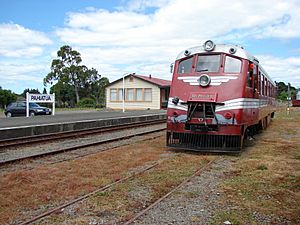Pahiatua Railcar Society facts for kids
The Pahiatua Railcar Society (PRS) is a group in Pahiatua, New Zealand. They work to fix up old railcars, trains, and other railway vehicles. These vehicles used to be run by the New Zealand Railways Department. The PRS is special because it has the only remaining examples of the 88-seater and Wairarapa railcars.
The Society fixed up a Standard class railcar, Rm 31. It was made ready to run on the main railway lines. The PRS ran its first public trips on the Wairarapa Line on February 12, 2012. This happened during an open day event.
Contents
The Society's Home Base
The PRS is located at Pahiatua's railway station. This station is on the Wairarapa Line. The Society has worked hard to keep the station building, the goods shed, and the surrounding area in good condition.
The Station Building
The railway station building is made of wood. It was built in 1971. This building replaced an older one from 1897 that had been taken down. It is one of the last wooden stations built by the New Zealand Railways Department. It is also one of the few stations of its kind still standing.
Goods Shed and Other Buildings
The goods shed at Pahiatua dates back to 1897. It is one of the larger rural goods sheds that still exists in New Zealand. The PRS has also built its own structures at the station. These include a railcar shed for storing and fixing vehicles. There is also another shed to protect the Society's other railway vehicles.
The Society's Collection of Vehicles
The Pahiatua Railcar Society has a cool collection of old railway vehicles. They work to restore these vehicles to their former glory.
Railcars
The PRS has several different types of railcars. Railcars are like buses that run on train tracks.
| Key: | In service, Mainline Certified | In service | Under overhaul/restoration | Stored | Static display | Scrapped |
|---|
| Original class
and number |
TMS number | Name | Builder | Year Built | Arrived | Notes |
|---|---|---|---|---|---|---|
| Rm 1 | RM 18 | Nissho Iwai | 1972 | 2020 | ||
| Rm 2 | RM 24 | Nissho Iwai | 1972 | 2020 | ||
| Rm 3 | RM 30 | Nissho Iwai | 1972 | 2020 | ||
| Rm 5 | Mahuhu | NZR Hutt | 1936 | 1992 | Leased from Silver Stream Railway | |
| Rm 31 | Tokomaru | NZR Hutt | 1938 | 2001 | ||
| Rm 34 | Tainui | NZR Hutt | 1938 | 2019 | ||
| Rm 121 | Birmingham Railway Carriage and Wagon Company on behalf of Drewry Car Company | 1956 | 2003 | Owned by the RM 133 Railcar Trust Board | ||
| Rm 133 | Birmingham Railway Carriage and Wagon Company on behalf of Drewry Car Company | 1956 | 2002 | Owned by the RM 133 Railcar Trust Board |
Rm 31 is the only railcar that the Society currently operates. It is one of four Standard class railcars that have been saved. The PRS is working hard to restore Rm 5, which needed a lot of rebuilding because its wooden frame was rotten. They are also restoring Rm 121. Parts from Rm 119 and Rm 133 are being used to help fix Rm 121.
For a long time, people thought that no 88-seater railcars would be saved. But the PRS and the Rm 133 Railcar Trust Board found Rm 133. It had been used by rescue services for training at Auckland International Airport. Since both ends of Rm 133 were damaged by fire, the Society decided to focus all their efforts on restoring Rm 121. Both ends of Rm 121 have now been found. Other parts have come from the remains of Rm 133 and Rm 119. The Society hopes to fully rebuild an 88-seater railcar that can run again.
In September 2020, the Society announced that they had bought three Silver Fern Railcars. These railcars had recently been retired by KiwiRail.
Diesel Locomotives
The Society also has some diesel locomotives. These are smaller trains used for moving other railway vehicles around.
| Key: | In service, Mainline Certified | In service | Under overhaul/restoration | Stored | Static display | Scrapped |
|---|
| Original class
and number |
Builder | Year Built | Arrived | Notes |
|---|---|---|---|---|
| TR 36 | Drewry Car Company | 1939 | ||
| TR 160 | A & G Price | 1959 | 2004 | |
| PWD D 597 | 1937 |
The two TR locomotives are small shunting locomotives. Shunting means moving railway cars around a yard. The PWD D class is another shunting locomotive. This one was only used by the Public Works Department (PWD) for their building projects. It was never owned by the Railways Department.
Other Equipment
The Society also has three jiggers. These are small trolleys that railway workers used to ride on the tracks. Two of them have motors, and one is powered by hand. They also have the turntable from Thames. A turntable is a rotating platform used to turn locomotives around.
Wagons
The Society's collection of railway vehicles also includes many different types of wagons. Wagons are cars that carry goods. They have both four-wheel wagons and bogie wagons. Bogie wagons have special wheel sets that help them go around curves better. The wagons include everything from a guard's van to wagons for carrying cement and sheep.
| Key: | In service, Mainline Certified | In service | Under overhaul/restoration | Stored | Static display | Scrapped |
|---|
| Original class
and number |
Type | Year Built | Notes |
|---|---|---|---|
| Bc 70 | 4 wheel cement wagon | 1963 | |
| Jc 4857 | 4 wheel sheep wagon | 1967 | |
| Kp 2714 | 4 wheel steel box wagon | 196? | |
| La 15097 | 4 wheel highsided wagon | 1920 | |
| Lb 3217 | 4 wheel highsided wagon | 1976 | |
| Lb 2854 | 4 wheel highsided wagon | 197? | |
| Mc 2383 | 4 wheel lowside wagon | 1967 | |
| Mcc 2023 | 4 wheel motorcar wagon | 1941 | |
| Rb 558 | Bogie highside wagon | 1952 | |
| T 218 | Bogie cattle wagon | 1965 | |
| Ub 1208 | Bogie flat wagon | 1950 | Supporting No. 1 end of RM121 |
| Ur 1953 | Bogie flat wagon | 1964 | Supporting No. 2 end of RM121 |
| Uc 824 | Bogie tank wagon | 1928 | |
| Vr 20 | Bogie insulated wagon | 196? | |
| W 1235 | 4 wheel insulated box wagon | 1960 | |
| Yb 581 | 4 wheel ballast wagon | 1942 | |
| Za 1327 | Bogie steel box wagon | 1976 |
Images for kids





